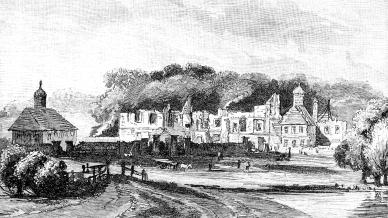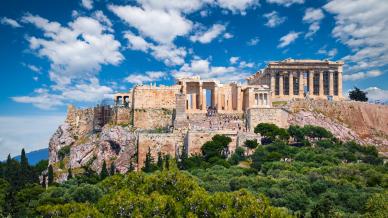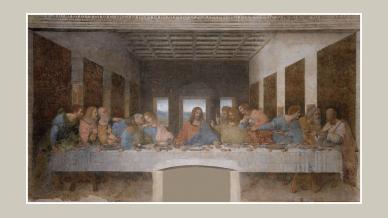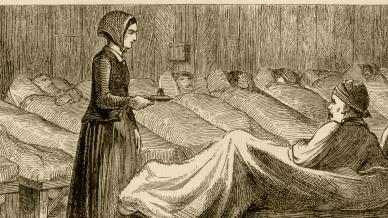Has any year in history ever accumulated so many names as 1816? ‘The Year Without a Summer’, ‘The Poverty Year’, ‘The Summer That Never Was’. The Americans still refer to 1816 as ‘1800 and Froze to Death’, while the Germans and French have their own sorry labels too.
By every account, 1816 was miserable. Instead of warm sun and welcome rains, our ancestors suffered constant wet, wintry temperatures and sombre skies throughout the whole year. The bad weather drove the news agenda and set the national mood.
Today, meteorologists have a vast array of scientific studies, satellites, radars and news channels to chart the direction and triggers of weather variability. El Nino, the Gulf Stream, Saharan sandstorms, global warming and phenomena like the ‘Beast from the East’ help us to understand the reasons behind seasonal outliers when they arrive.
In 1816, they had no such insight. The real reason behind the deep chill – the terrifying eruption of Mount Tambora in Indonesia – was unknown for over a century. To put the blast into context, Tambora was one thousand times more powerful than the Icelandic volcano that caused mayhem to international air travel in 2010. Ash clouds were launched 25 miles into the stratosphere, high enough to reflect solar energy and cool a vast swathe of the planet.
In the absence of fact, it’s no surprise that people began turning to obscure predictions or supernatural theories to explain the ‘end of the world’. There was an upsurge in religious fervour. Jane Austen, who was in her last summer, captured the despair: “It really is too bad and has been for a long time much worse than anybody can bear, and I begin to think it will never be fine again.”
Impacts that echo through time
The historian John D. Post described 1816 as “the last great subsistence crisis in the Western world” as crop failures caused major food shortages across the Northern Hemisphere. The unseasonal cold seeped as far as the Eastern Seaboard of America, where inch-thick ice formed in New York during May. The story goes that during a warmer snap in June, farmers in Massachusetts sheared the sheep. But when the temperatures fell back below zero that night, they had to fit the fleeces back on their sheep to prevent them from freezing to death.
Families emigrated from New England to the promised lands of Ohio and Pennsylvania in search of better weather for their livestock. Mormon communities grew up in the Midwest as an indirect consequence of 1816’s appalling weather, while liberal ideas around the abolition of slavery also travelled into the hinterland.
In Ireland, 65,000 people died of typhus in the second half of the decade, a premonition of the Potato Famine some 30 years later. India suffered terrible cholera outbreaks. In China, a catastrophic rice famine caused many farmers to shift to opium farming, leading to the Opium Wars in the middle of the century.
In the UK and throughout Europe, civil unrest grew to fever pitch, as the poor suffered from hunger, ill-health and high food prices. With the French Revolution fresh in the memory of governments, any uprisings – such as the Spa Field Riots in London and the Pentrich Revolution in Derbyshire – were quickly (and forcibly) suppressed.
Creative deluge
There was, perhaps, a silver lining to the oppressive weather, as it gave a creative push to the Romantic Movement. In 1816, Mary Shelley conceived her Frankenstein monster, seemingly affected by the moody stormscapes outside her window at Lake Diodati near Geneva. Lord Byron envisioned the end of the universe in his poem Darkness, while his friend and physician John William Polidori was inspired to launch the vampire horror genre. The filthy cold and rain made them all stay inside and write.
Samuel Taylor Coleridge was another forced to work overtime. He cursed the “end-of-the-world weather” that prohibited his daily exercise. He escaped by imagining the fantastic landscapes of Kubla Khan. The melancholy of Jane Austen’s Persuasion captures the angst of the period. Dramatic storms and sulphuric skies also fuelled the rise of Romantic art, most famously in the works of J.M.W. Turner and Casper Friedrich.
History repeating?
Can we empathise with those poor souls who lived through the misery of 1816? For anyone who went on staycation in July this year, then 2023 has felt like the year without a summer. Yet, our soggy holidays surely can’t compare to cold rain, fog and occasional snow showers from April through to September, nor the biting hunger and clawing damp.
Perhaps the uncertainty of the COVID-19 pandemic provides a closer correlation. After all, those were months of deep anxiety, terrible loss of life, rampant fake news and political instability, and with no clear explanation or resolution in sight. For those shut indoors for months on end, or cut off from human contact, the atmosphere was heavy indeed.
There were silver linings too. In adversity, many people discovered a new creativity within themselves and we learned to value family and friends as never before. The pandemic brought innovation. New communities formed.
In two centuries from now, I wonder what they’ll call the year 2020?
Inspired?
For more food for thought, why not become a member for £15 a year and enjoy our weekly online lectures. Click the button below for more details.
















